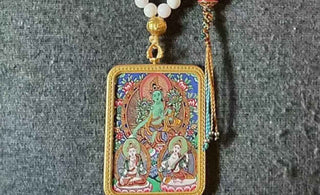
In the intricate world of Thangka painting, the marriage of captivating colors and intricate details becomes a symphony of artistry that transcends the boundaries of conventional painting. Thangka, a traditional Tibetan art form, is a visual expression deeply rooted in spiritual narratives, where every stroke of the brush and every chosen hue is a deliberate act of artistic devotion.
The artistry of Thangka painting is a nuanced dance between captivating colors and the meticulous rendering of intricate details. At its heart, the choice of colors is not arbitrary; it is a profound selection rooted in Buddhist iconography. Each hue carries symbolic significance, becoming a vessel for spiritual expression. The vibrant reds may symbolize the fiery energy of wisdom, while serene blues evoke the calm waters of compassion. This intentional palette is a visual language, a conduit for the artist to communicate the essence of the spiritual narrative being depicted.
The process of applying captivating colors to a Thangka canvas is not a mere act of painting; it is a spiritual dialogue with each pigment. The artist, as a spiritual practitioner, engages in a meditative practice with each stroke of the brush. The act becomes a rhythmic prayer, resonating with intention and mindfulness. The canvas, slowly transforming with the infusion of vibrant colors, becomes a sacred space where the artist's devotion takes tangible form.
However, the artistry of Thangka painting extends beyond the palette of captivating colors; it delves into the realm of intricate details that breathe life into the canvas. Every lotus petal, celestial being, or ornate pattern in a deity's attire is a deliberate choice made with spiritual significance. The details are not mere embellishments; they are sacred elements contributing to the larger narrative. The artist's attention to detail is akin to a form of devotion, where every nuance becomes an offering to the divine intricacies being portrayed.
The application of gold leaf in Thangka painting adds another layer to the artistry. Beyond its aesthetic allure, gold in Buddhist philosophy represents purity and enlightenment. The meticulous placement of each gold leaf is a deliberate act of reverence, elevating the ordinary into the extraordinary, the mundane into the sacred. This infusion of gold becomes a visual hymn, a luminous touch that symbolizes the divine radiance associated with enlightened beings.
In the completed Thangka painting, the culmination of captivating colors and intricate details stands as a testament to the artist's artistry and spiritual practice.
In the completed Thangka painting, such as the exquisite "18th Century White Tara Tibetan Antique Thangka Hand-painted With Mineral Color Materials Menbris Sama Style," the culmination of captivating colors and intricate details serves as a profound testament to the artist's unparalleled artistry and unwavering spiritual practice. The canvas of this ancient masterpiece becomes a sacred space where artistic brilliance converges with devotion, creating a visual narrative that transcends the boundaries of time.
The captivating colors employed in the "18th Century White Tara" Thangka are not mere pigments; they are a carefully chosen palette that communicates with spiritual resonance. The serene whites and blues delicately blend to portray the divine embodiment of White Tara, the compassionate goddess of longevity. Each stroke of the brush becomes a meditative prayer, infusing the canvas with intention and mindfulness. The vibrant colors, symbolizing purity and enlightenment, create a visual symphony that resonates with the core tenets of Buddhist philosophy.
As the eyes wander across the canvas, the intricate details of the "Menbris Sama Style" Thangka captivate the observer. Every meticulous rendering, from the delicate features of White Tara to the ornate patterns adorning her attire, is a testament to the artist's dedication to precision. The lotus petals, the celestial beings surrounding the goddess, and the divine aura are not mere embellishments but integral elements contributing to the spiritual narrative. The details become a language that speaks to the viewer, inviting them into a realm where every nuance is a sacred offering.
The application of mineral color materials and the Menbris Sama style further enhance the artistry of this Thangka. The Menbris Sama technique, known for its intricate detailing and vibrant color palette, becomes a distinctive mark of the artist's skill. The careful placement of each mineral color material is akin to a form of devotion, a deliberate act that elevates the divine presence portrayed on the canvas. The use of mineral colors, sourced from the earth's treasures, adds an additional layer of significance, connecting the Thangka to the natural world.
In the "18th Century White Tara" Thangka, the culmination of captivating colors and intricate details goes beyond a mere visual spectacle. It becomes a transcendent experience, an encounter with a timeless masterpiece that carries the whispers of devotion and artistic brilliance through the ages. The canvas stands as a testament to the profound connection between the artist and the divine, where each stroke of the brush becomes a sacred offering, and each color is a hymn to the spiritual richness embedded in Tibetan culture.
As viewers engage with the "18th Century White Tara" Thangka, they embark on a visual journey through the artist's devotion and the spiritual narratives woven into the fabric of the canvas. The captivating colors and intricate details create a harmonious symphony, inviting contemplation and connection with the divine.
The canvas becomes a sacred object, a visual offering that transcends the material realm. Viewers are invited into a realm where the convergence of colors and details creates a visual tapestry that tells a story beyond words. The artistry of Thangka painting, with its captivating colors and intricate details, is a timeless dance that resonates with the essence of spirituality and artistic devotion.
























